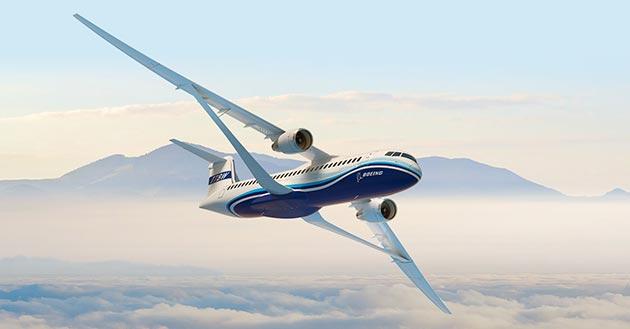Designed to be more aerodynamic and fuel efficient, Boeing has unveiled an ultra-light wing that they hope will reduce fuel burn by 60 per cent.
Called the Transonic Truss-Braced Wing (TTBW), this new concept was presented on Tuesday at the American Institute of Aeronautics and Astronautics (AIAA) Science and Technology Forum and Exposition in San Diego, California.
For nearly a decade, the world’s largest aeroplane maker Boeing has been collaborating with the US space agency NASA as part of the Subsonic Ultra Green Aircraft Research Program to develop concepts that will reduce aircraft noise, emissions and fuel burn while enhancing performance.
The Transonic Truss-Braced Wing is a folding wing that measures 52 metres (170 feet) from end to end. The high wingspan is made possible by the presence of a truss, which supports the extended length of the ultra-thin wing in a design reminiscent of biplanes from the early years of aviation, or the evergreen Cessna 172.
Originally, the TTBW was designed to fly at speeds of Mach 0.70–075 but tweaks to the plane’s design that adjust the wing sweep angle and allow the truss to carry lift more efficiently, allows it to fly at speeds of Mach 0.8, or about 965 km/h (520 knots), slightly faster than previous designs but faster than some current passenger jetliners.



Interesting concept. But it won’t eventuate.
60% reduction in fuel burn??? Would be interesting to read how that is actually planned to be achieved. Although perhaps I should read carefully.. The hint might be there all the time… it says… “hoped” to be achieved.
I’m “hoping” for a 100% reduction in fuel burn on my aircraft, but still waiting patiently. But seriously, more details would be helpful.
Oh Gilbert, go back and read the Sci Fi back in the 50’s and 60’s. Dick Tracys two way wrist radio was never going to happen was it? and where are we now? We need these brains to progress. One day we might just get to a point where all nations get together to deal with a problem coming from outer space….
I have a collection of more than 2600 SF books dating from the earliest classics! I am also a pilot with 51 years since my first solo. The reason I said that flying cars and numerous drones are unlikely, or even impossible, is that airspace is not policable like roads, the skills are different and more complicated, and they are very inefficient. Also, recall the recent shut downs of Gatwick and Heathrow airports thanks to lunatics with drones. PS. I have a few myself!
Oh ye of little faith! Remember, if you don’t have a goal, you’re not moving in that direction.
I think Boeing should be taken more seriously by some of out esteemed commentators here. Even A 20% reduction would be significant. …
I think they mean 60% reduction over standard wings – i.e. 60% less drag with reference to the wing components. This is a great result and should translate to cheaper fares.
It is a worry that some commenters do not understand the basic physics of flight. If at the same airspeed/air density, the same lift can be achieved with a 60% reduction in total drag, the thrust required (ie energy required, ie fuel burn) will be reduced by 60%. In cruise most of the total drag of a modern aircraft is induced drag of the wing with some skin friction drag. The new wing could potentially reduce total drag by 60%.
Using words like “could potentially” makes me tend to agree with your post.
Then new wing design could potentially reduce the total drag by 5% and until they provide proof, that’s about what I would expect. Don’t forget there are around 10 types of drag acting on a plane, not least of which is just pushing those big engines through the air.
I only tried to (subtly) suggest article writers on this respected forum keep to realistic and informative propositions. There’s enough pie in the sky claims elsewhere.
I’ve rarely ever posted on any forum and am not trying to come across as pretentious, but since I’m one of the worrying commentators that doesn’t understand the basic physics of flight, I must have been really lucky to attain 2 (current) FAI Aircraft Efficiency World Records and an FAI World Speed Record in an aircraft I solely constructed, developed and piloted.
Anyway, despite this story originating from Boeing, my humble calculations still say you could likely throw the wing away altogether and the bits left over would likely preclude a 60% drag reduction, so in the absence of more info I’ll stay in the “Gilbert” camp for now.
Ok, off now to sprinkle some more fairy dust on my latest project ha ha!
Thanks. I wish I had your way with words.
I particularly like the fairy dust concept which is rife in the news nowadays. Unless the news is blatantly and completely fake.
I think some designers are snorting the white stuff too much! Never gunna happen! Design concepts are one thing practical everyday use at large airports are another thing! 0.8 520 kts? Like to see that!! Dream on guys! -:)
Robin – I assume you’re referencing the Sonerai IIL you built. I also have a Sonerai under construction and am planning on using a Rotax ULS/S with a variable pitch propeller. I find what you were able to do with your Sonerai very inspirational and would be interested in any modifications and lessons learned you are willing to share. Please contact me at jonfilipa@gmail.com if you are willing to pass on any information. Thanks!